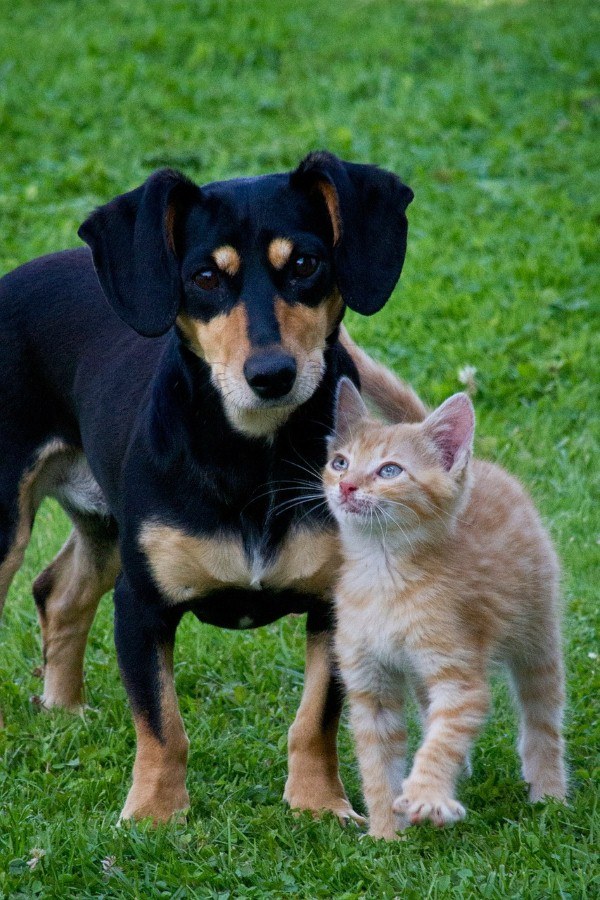
Many pet owners own more than one kind of animal; after all, furry friends come in all shapes and sizes! For you, this offers a lovely variety of characteristics to observe and lots of different interactions to enjoy. However, it also comes with a few challenges, not least of which is making sure the various members of your household get along.
Whether your dog is the newcomer or the long-established boss of the household, you will need to introduce your animals to each other slowly, monitoring their interactions at all times.
Will your dog get along with other pets?
Before adding more pets to your home, think carefully about whether they are likely to get along. Fortunately, with time, patience and a watchful eye, it is possible to persuade most dogs to get along well with the family cat or rabbits - but you shouldn't assume this will be the case.
If you already have a dog and are thinking of getting a cat or rabbit, think about its history and general behaviour before going ahead. Has your dog even killed or seriously harmed another animal, or is he prone to becoming unruly when excited? If your pooch has killed other creatures or can be difficult to control when in high spirits, this could be a real barrier to him getting on safely with other pets.
Introducing puppies to cats
Your cat is unlikely to relish the arrival of a puppy into your home, so don't be surprised if you notice him becoming territorial, or even slightly aggressive towards your puppy, such as swatting at him.
The first thing to remember is that your cat will feel threatened by the new arrival in more ways than one. His space will feel invaded, he will feel competitive for your attention, and may be frightened by this canine newcomer. So, it is crucial that you alleviate these worries by giving your cat the five-star treatment. This means feeding them first, playing with them more, and not immediately moving away from them if the puppy demands attention. This way, they will feel their territory - and their place in the home - is more secure.
You will need to keep your puppy in a confined area for the beginning of his house training anyway, and this works well for gradually introducing him to your cat. When introducing the two, move gradually - place the puppy in an enclosed room or play pen, and allow the cat to come in and explore the room as it pleases. Leave it to its own devices - don't force a close-up meeting.
If your cat bats at the puppy or hisses, don't try to correct this behaviour; it is important that he is given the opportunity to define his personal space. If, however, the puppy starts to act overly excited or aggressive, step in to calm him.
Your primary goal is to make sure your pets are calm in one another's company. It's likely you will need to introduce them in this safe way for short periods daily, making sure that your dog is restrained on a lead or in a crate or playpen, or that your cat is in a pen. Reward your dog with tidbits for being calm.
Practise this exercise in different rooms of the house, making sure they get used to each other's presence and scent before allowing them to meet one another outside of their pen or cage. When you let either your cat or dog free of their pen (depending on which you have been keeping inside), make sure your dog remains on his lead, and keep going with these daily introductory sessions. Only remove the lead once you're sure your dog won't react.
Introducing a new cat to your dog
If your dog is the current resident and you are planning to add a cat to the household, the introduction process is similar. Again, your focus should be on getting the animals used to one another's scents, as well as being calm in each other's presence. And also as previously, you will need to monitor their interactions until they become comfortable with one another.
The main difference is that your cat will be getting used to a whole new home, which means that they will usually be confined to a single room. For your dog, the arrival of a cat means new smells and, potentially, the urge to hunt and chase - even just in play.
So, takes things slowly again. Feed your cat and dog on either side of the same door and from time to time place each other's bedding in the other's territory - both exercises allow them to get used to each other's scent.
Before making physical introductions, ensure your dog is fully responsive to commands to sit, come, stay and get down - even when excited. Only then begin with face to face introductions, with your dog on a leash, as described above. Have a family member or friend sit with your cat during these visits to offer treats.
After a few calm meetings, you can let your new cat come and meet your dog, who will still be on his leash. Continue to reward your dog for calm behaviour. If your cat becomes afraid or aggressive during this time, go back a step.
Once you are confident they are calm in each other's presence, you can try letting your dog off his leash. While the two might not become particularly close (though this can happen!), they should be able to live harmoniously. To promote this, ensure your cat has plenty of toys so it isn't tempted to hassle your dog, and that it has somewhere high to retreat from your pooch if he wants to.
Written by: Hannah








